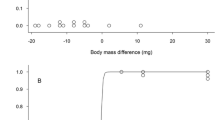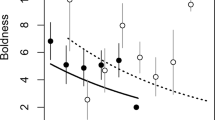Abstract
Although contemporary animal contest theory emphasises the importance of physical asymmetries in resolving disputes, such asymmetries do not obviously settle fights in all groups. Territorial male butterflies, for example, compete via elaborate non-contact aerial interactions in which success is determined by relative persistence. Prior research suggests that the resolution of these contests is not clearly related to physical variables such as body size or energy reserves. However, given that the contests involve elaborate aerial manoeuvres, one long-standing suggestion is that asymmetries in flight performance, and thus flight morphology, may be important. We addressed this hypothesis via a manipulative investigation into the biophysical correlates of contest success in the speckled wood butterfly, Pararge aegeria. This species possesses the ability for significant adaptive phenotypic plasticity in relevant flight morphological parameters. We took advantage of this plasticity to rear 90 individuals of markedly varying flight morphologies, which we then pitted against each other in a semi-controlled experimental fashion. Multiple logistic and lognormal analyses provided little evidence for the relevance of morphological parameters, including relative flight musculature, wing loading and wing aspect ratio (wing length relative to area), to the outcome and/or duration of experimental contests. Instead, we found a positive effect of age upon contest success. Given that ability for high acceleration is strongly linked to variation in these morphological parameters, our findings suggest that flight performance is not a strong determinant of resource-holding potential in this notably territorial butterfly.




Similar content being viewed by others
References
Alcock J (1987) Male reproductive tactics in the Libellulid dragonfly Paltothemis lineatipes: temporal partitioning of territories. Behaviour 103:157–173
Alcock J (1993) The effects of male body size on territorial and mating success in the landmark-defending fly Hermetia comstocki (Stratiomyidae). Ecol Entomol 18:1–6
Alcock J, Bailey WJ (1997) Success in territorial defence by male tarantula hawk wasps Hemipepsis ustulata: the role of residency. Ecol Entomol 22:377–383
Alcock J, Schaefer JE (1983) Hilltop territoriality in a Sonoran Desert bot fly (Diptera: Cuterebridae). Anim Behav 31:518–525
Baker RR (1972) Territorial behaviour of the nymphalid butterflies, Aglais urticae (L.) and Inachis io (L.). J Anim Ecol 41:453–469
Berwaerts K, Van Dyck H, Aerts P (2002) Does flight morphology relate to flight performance? An experimental test with the butterfly Pararge aegeria. Funct Ecol 26:484–491
Burnham KP, Anderson DR (2002) Model selection and multimodel inference: a practical information–theoretic approach. Springer, Berlin Heidelberg New York
Convey P (1989) Influences on the choice between territorial and satellite behaviour in male Libellula quadrimaculata Linn. (Odonata: Libellulidae). Behaviour 109:125–141
Davies NB (1978) Territorial defence in the speckled wood butterfly (Pararge aegeria): the resident always wins. Anim Behav 26:138–147
Dudley R (2000) The biomechanics of insect flight: form, function, evolution. Princeton University Press, Princeton
Enquist M, Leimar O (1983) Evolution of fighting behaviour: decision rules and assessment of relative strength. J Theor Biol 102:387–410
Hernández MIM, Benson WW (1998) Small-male advantage in the territorial butterfly Heliconius sara (Nymphalidae): a paradoxical strategy? Anim Behav 56:533–540
Karlsson B (1994) Feeding habits and change of body composition with age in three nymphalid butterfly species. Oikos 69:224–230
Kemp DJ (2000) Contest behaviour in territorial male butterflies: does size matter? Behav Ecol 11:591–596
Kemp DJ (2002a) Butterfly contests and flight physiology: why do older males fight harder? Behav Ecol 13:456–461
Kemp DJ (2002b) Sexual selection constrained by life history in a butterfly. Proc R Soc Lond B Biol Sci 269:1341–1345
Kemp DJ, Alcock J (2003) Lifetime resource utilization, flight physiology and the evolution of contest competition in territorial insects. Am Nat 162:290–301
Kemp DJ, Wiklund C (2001) Fighting without weaponry: a review of male–male contest competition in butterflies. Behav Ecol Sociobiol 49:429–442
Kemp DJ, Wiklund C (2004) Residency effects in animal contests. Proc R Soc Lond B Biol Sci 271:1707–1711
Marden JH (1987) Maximum lift production during takeoff in flying animals. J Exp Biol 130:235–258
Marden JH (1989) Bodybuilding dragonflies: costs and benefits of maximising flight muscle. Physiol Zool 62:505–521
Marden JH (2000) Variability in the size, composition, and function of insect flight muscles. Annu Rev Physiol 62:157–178
Marden JH, Chai P (1991) Aerial predation and butterfly design: how palatability, mimicry, and the need for evasive flight constrain mass allocation. Am Nat 138:15–36
Marden JH, Waage JK (1990) Escalated damselfly territorial contests are energetic wars of attrition. Anim Behav 39:954–959
Maynard Smith J (1982) Evolution and the theory of games. Cambridge University Press, Cambridge
Nylin S, Wickman P-O, Wiklund C (1995) Life-cycle regulation and life history plasticity in the speckled wood butterfly—are reaction norms predictable? Biol J Linn Soc 55:143–157
Parker GA (1974) Assessment strategy and the evolution of fighting behaviour. J Theor Biol 47:223–243
Payne RJH (1998) Gradually escalating fights and displays: the cumulative assessment model. Anim Behav 56:651–662
Rosenberg RH, Enquist M (1991) Contest behaviour in Weidemeyer's admiral butterfly Limenitis weidemeyerii (Nymphalidae): the effect of size and residency. Anim Behav 42:805–811
Rutowski RL (1991) The evolution of male mate-locating behavior in butterflies. Am Nat 138:1121–1139
Scott JA (1983) Mate-locating behaviour of western North American butterflies. II. New observations and morphological adaptations. J Res Lepid 21:177–187
Srygley RB (1994) Locomotor mimicry in butterflies? The associations of positions of centres of mass among groups of mimetic, unprofitable prey. Philos Trans R Soc Lond B Biol Sci 343:145–155
Srygley RB, Kingsolver JG (2000) Effects of weight loading on flight performance and survival of palatable Neotropical Anartia fatima butterflies. Biol J Linn Soc 70:707–725
Stjernholm F, Karlsson B (2000) Nuptial gifts and the use of body resources for reproduction in the green-veined white butterfly Pieris napi. Proc R Soc Lond B Biol Sci 267:807–811
Stutt AD, Willmer P (1998) Territorial defence in speckled wood butterflies: do the hottest males always win? Anim Behav 55:1341–1347
Taylor PW, Elwood RW (2003) The mismeasure of animal contests. Anim Behav 65:1195–1202
Van Dyck H, Wiklund C (2002) Seasonal butterfly design: morphological plasticity among three developmental pathways relative to sex, flight and thermoregulation. J Evol Biol 15:216–225
Van Dyck H, Matthysen E, Dhondt AA (1997) Mate-locating strategies are related to relative body length and wing colour in the speckled wood butterfly, Pararge aegeria (L). Ecol Entomol 22:116–120
Waage JK (1988) Confusion over residency and the escalation of damselfly territorial disputes. Anim Behav 36:586–595
Wickman P-O (1992) Sexual selection and butterfly design—a comparative study. Evolution 46:1525–1536
Wickman P-O, Wiklund C (1983) Territorial defence and its seasonal decline in the speckled wood butterfly (Pararge aegeria). Anim Behav 31:1206–1216
Windig JJ, Nylin S (1999) Adaptive wing asymmetry in males of the speckled wood butterfly (Pararge aegeria)? Proc R Soc Lond B Biol Sci 266:1413–1418
Acknowledgements
We thank John Alcock, Mark Elgar and two anonymous reviewers for helpful comments and Maarten Jacobs for assistance with measuring the butterflies. The Swedish Research Council supported DJK and CW.
Author information
Authors and Affiliations
Corresponding author
Additional information
Communicated by N. Wedell.
Rights and permissions
About this article
Cite this article
Kemp, D.J., Wiklund, C. & Van Dyck, H. Contest behaviour in the speckled wood butterfly (Pararge aegeria): seasonal phenotypic plasticity and the functional significance of flight performance. Behav Ecol Sociobiol 59, 403–411 (2006). https://doi.org/10.1007/s00265-005-0064-1
Received:
Revised:
Accepted:
Published:
Issue Date:
DOI: https://doi.org/10.1007/s00265-005-0064-1




